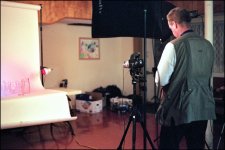I might deserve a spanking for asking such a basic question, but, what does the aperature have to do with the actual plane of focus of a given lens? In other words, the focal plane distance is exclusively deterimined by the relationship of the lens elements to the film plane, and linked to the rangefinder mechanism via the cam and so on. The lens iris blade opening determines the aperature setting which effects the amount of light entering the lens and creates the apparent depth of field zone. At large and small aperature settings, certain anomolies can occur, such as diffraction, flare and vignetting. The actual focal plane remains constant at any given aperature setting because the lens elements are not moved by the adjustment of the aperature. I would propose that the lenses commented on above are in fact mis-adjusted at the factory, and they appear better focused at middle aperatures because the intended focal plane then falls into a widened focal zone. (whew!) Please correct me if I am not informed properly on this point.
I have not performed any scientific tests of my Sonnar C 50/1.5, but after reading this thread, I intend to. So far, my casual touristy snaps and informal interior portraits on a ZI body have been extremely satisfying. I've had no obvious focal plane problems. Nice and sharp where I want it. And, over-all, I love the signature of this lens, what ever that means. lens sr #156001xx



